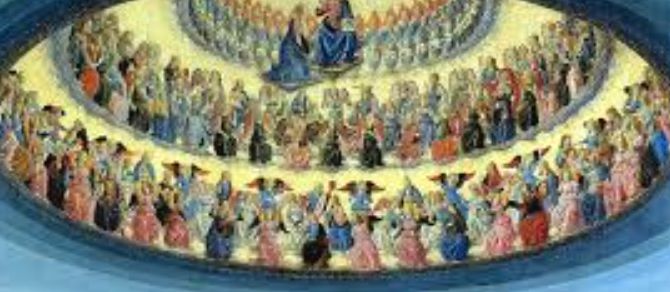By Shanaz Joan Parsan
Abstract (concept)
This work explores the Nine Choirs of Angels as understood in Catholic theology—how they participate in divine order, mediate grace, and interact with humanity. Drawing from Scripture, Pseudo-Dionysius, St. Thomas Aquinas, St. Bonaventure, and the Catechism of the Catholic Church, it presents the angelic hierarchy not as remote speculation but as a living communion of service. The essay concludes that invoking the angels is a form of contemplative participation in their praise—a way of drawing near to the divine harmony they eternally sing.
1. Origins of the Angelic Hierarchy
- Scriptural foundations:
- Isaiah 6:2 (Seraphim), Ezekiel 10 (Cherubim), Colossians 1:16 (“thrones or dominions or principalities or powers”).
- Daniel 10:13, 12:1 (Michael as “one of the chief princes”).
- Luke 1:26 (Gabriel as messenger).
- Early interpretation: Pseudo-Dionysius Celestial Hierarchy (5th–6th c.) organizes them into three triads of three choirs each.
- Purpose: Not rank for pride but order for love; hierarchy means “holy beginning” (hierarchia).
2. The Three Hierarchies
I. The First Hierarchy – Those Closest to God
Contemplative orders: Seraphim, Cherubim, Thrones
They adore and contemplate the divine mystery directly.
- Seraphim – “Burning ones.” (Is 6:2–3)
Symbolize perfect charity and union with God. Their fire purifies; their song, “Holy, Holy, Holy,” echoes in the Mass.
Invocation: Pray for purity of heart and love that consumes sin.
Patristic note: St. Gregory the Great—“They kindle others with the fire of divine love.” - Cherubim – “Fullness of wisdom.” (Gen 3:24, Ez 10)
Guardians of divine knowledge; their wings veil mystery.
Invocation: Pray for enlightenment and discernment in truth.
Aquinas: They “excel in knowledge of divine secrets” (ST I.108.5). - Thrones – “Seat of divine justice.” (Col 1:16)
Channels of divine will; symbolize humility, bearing God’s judgment with serenity.
Invocation: Ask them to intercede for right judgment and peaceful acceptance of God’s will.
II. The Second Hierarchy – The Governors of Creation
They order and maintain the cosmos and the spiritual battle against evil: Dominions, Virtues, Powers.
- Dominions – (Col 1:16) Regulate the duties of lower angels; manifest divine sovereignty without tyranny.
Invocation: For leaders, governments, and the grace of holy authority. - Virtues – (1 Pt 3:22) The angels of miracles and cosmic harmony; their strength maintains creation’s stability.
Invocation: For courage in adversity and steadfastness in vocation. - Powers – (Eph 6:12) Guardians of order against the demonic. They restrain chaos and maintain balance.
Invocation: For deliverance from oppression and perseverance in spiritual warfare.
III. The Third Hierarchy – The Ministers of Humanity
Messengers and guardians: Principalities, Archangels, Angels.
- Principalities – (Eph 3:10, Col 1:16) Protect nations, dioceses, and communities; guide collective destinies toward divine plan.
Invocation: For peace among nations and sanctification of the Church. - Archangels – The great messengers: Michael (defense), Gabriel (revelation), Raphael (healing).
Invocation:- St. Michael: Protection against evil (Rev 12:7; Prayer of Leo XIII).
- St. Gabriel: Illumination and understanding of God’s message.
- St. Raphael: Healing of body and soul (Tob 12:15).
- Angels – Guardian spirits of individuals (Mt 18:10; Ps 91:11).
Their ministry is personal and continuous.
Invocation: Daily prayer of companionship, gratitude, and trust: “Angel of God, my guardian dear, to whom God’s love commits me here…”
3. The Angels and Human Life
- Mediation of grace: Aquinas: “The divine wisdom ordains that lower beings be brought to perfection by higher” (ST I.111.1).
- Angels illuminate conscience, protect from danger, inspire good thoughts, and assist at Mass (CCC 336).
- Mystical participation: Every good action harmonizes with their song; sin is discord.
4. Invoking the Choirs
Invoking angels is not command but communion.
- Through liturgy: “With angels and archangels, and with all the hosts of heaven, we sing…” (Preface, Roman Missal).
- Through prayer and devotion:
- The Chaplet of St. Michael (approved by Pope Pius IX).
- Feast of the Archangels (September 29).
- Feast of the Guardian Angels (October 2).
- Through virtue: Living in charity and humility aligns the soul with angelic order.
5. Interaction with the Angelic Realm
- Interior prompting: gentle inspirations toward good; avoidance of evil.
- Protection: both physical and moral—“He shall give His angels charge over you” (Ps 91:11).
- At death: guardians present the soul to judgment (Lk 16:22).
- In heaven: they rejoice at the entrance of the redeemed (Lk 15:10).
6. Conclusion – The Music of Hierarchy
The Nine Choirs are not distant abstractions but facets of divine charity.
Seraphim burn with love; Cherubim shine with understanding; Thrones bear the weight of divine justice. Through them, God’s governance descends without rupture—from the order of the cosmos to the quiet protection of a single heart.
To invoke the angels is to tune the soul to heaven’s harmony.
Every “Glory Be,” every whispered prayer of faith, vibrates in that same choir where Michael defends, Gabriel proclaims, and Raphael heals.
“Bless the Lord, all you His angels, mighty in strength, who do His word.” (Psalm 103:20)
Key References (APA 7th)
Aquinas, T. (1947). Summa Theologiae. Benziger Brothers.
Catechism of the Catholic Church. (1997). 2nd ed. Libreria Editrice Vaticana.
Dionysius the Areopagite. (1899). The Celestial Hierarchy. Christian Classics Ethereal Library.
Gregory the Great. (1980). Homilies on the Gospels. NPNF II, Vol. XIII.
Holy Bible (RSV-CE). (2006). Ignatius Press.
Pius IX, Pope. (1851). Chaplet of St. Michael (indulgence decree).
